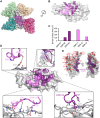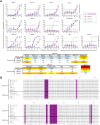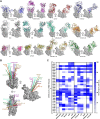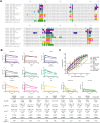Targeting the Spike Receptor Binding Domain Class V Cryptic Epitope by an Antibody with Pan-Sarbecovirus Activity
- PMID: 37395646
- PMCID: PMC10373542
- DOI: 10.1128/jvi.01596-22
Targeting the Spike Receptor Binding Domain Class V Cryptic Epitope by an Antibody with Pan-Sarbecovirus Activity
Abstract
Novel therapeutic monoclonal antibodies (MAbs) must accommodate comprehensive breadth of activity against diverse sarbecoviruses and high neutralization potency to overcome emerging variants. Here, we report the crystal structure of the severe acute respiratory syndrome coronavirus 2 (SARS-CoV-2) receptor binding domain (RBD) in complex with MAb WRAIR-2063, a moderate-potency neutralizing antibody with exceptional sarbecovirus breadth, that targets the highly conserved cryptic class V epitope. This epitope overlaps substantially with the spike protein N-terminal domain (NTD) -interacting region and is exposed only when the spike is in the open conformation, with one or more RBDs accessible. WRAIR-2063 binds the RBD of SARS-CoV-2 WA-1, all variants of concern (VoCs), and clade 1 to 4 sarbecoviruses with high affinity, demonstrating the conservation of this epitope and potential resiliency against variation. We compare structural features of additional class V antibodies with their reported neutralization capacity to further explore the utility of the class V epitope as a pan-sarbecovirus vaccine and therapeutic target. IMPORTANCE Characterization of MAbs against SARS-CoV-2, elicited through vaccination or natural infection, has provided vital immunotherapeutic options for curbing the COVID-19 pandemic and has supplied critical insights into SARS-CoV-2 escape, transmissibility, and mechanisms of viral inactivation. Neutralizing MAbs that target the RBD but do not block ACE2 binding are of particular interest because the epitopes are well conserved within sarbecoviruses and MAbs targeting this area demonstrate cross-reactivity. The class V RBD-targeted MAbs localize to an invariant site of vulnerability, provide a range of neutralization potency, and exhibit considerable breadth against divergent sarbecoviruses, with implications for vaccine and therapeutic development.
Keywords: COVID-19; SARS-CoV; SARS-CoV-2; X-ray crystallography; betacoronaviruses; convalescent; cryptic; epitope; neutralizing antibodies; receptor binding domain; sarbecoviruses; spike; structural biology; variants of concern.
Conflict of interest statement
The authors declare a conflict of interest. Patent application number PCT/US 63/140,763, PCT WO 2022/159839 A1 was filed containing the mAbs described in this publication for authors S.J.K., K.M., V.D., and N.L.M. M.G.J. and K.M. are named as inventors on international patent application WO/2021/178971 A1 entitled “Vaccines against SARS-CoV-2 and other coronaviruses.” M.G.J. is named as an inventor on international patent application WO/2018/081318 and U.S. patent 10,960,070 entitled “Prefusion coronavirus spike proteins and their use.” The other authors declare no competing interests.
Figures








References
-
- Ferdinands JM, Rao S, Dixon BE, Mitchell PK, DeSilva MB, Irving SA, Lewis N, Natarajan K, Stenehjem E, Grannis SJ, Han J, McEvoy C, Ong TC, Naleway AL, Reese SE, Embi PJ, Dascomb K, Klein NP, Griggs EP, Konatham D, Kharbanda AB, Yang DH, Fadel WF, Grisel N, Goddard K, Patel P, Liao IC, Birch R, Valvi NR, Reynolds S, Arndorfer J, Zerbo O, Dickerson M, Murthy K, Williams J, Bozio CH, Blanton L, Verani JR, Schrag SJ, Dalton AF, Wondimu MH, Link-Gelles R, Azziz-Baumgartner E, Barron MA, Gaglani M, Thompson MG, Fireman B. 2022. Waning 2-dose and 3-dose effectiveness of mRNA vaccines against COVID-19-associated emergency department and urgent care encounters and hospitalizations among adults during periods of Delta and Omicron variant predominance—VISION Network, 10 states, August 2021-January 2022. MMWR Morb Mortal Wkly Rep 71:255–263. doi:10.15585/mmwr.mm7107e2. - DOI - PMC - PubMed
-
- Reynolds CJ, Pade C, Gibbons JM, Otter AD, Lin K-M, Muñoz Sandoval D, Pieper FP, Butler DK, Liu S, Joy G, Forooghi N, Treibel TA, Manisty C, Moon JC, Semper A, Brooks T, McKnight Á, Altmann DM, Boyton RJ, Abbass H, Abiodun A, Alfarih M, Alldis Z, Altmann DM, Amin OE, Andiapen M, Artico J, Augusto JB, Baca GL, Bailey SNL, Bhuva AN, Boulter A, Bowles R, Boyton RJ, Bracken OV, O'Brien B, Brooks T, Bullock N, Butler DK, Captur G, Carr O, Champion N, Chan C, Chandran A, Coleman T, Couto de Sousa J, Couto-Parada X, Cross E, Cutino-Moguel T, D'Arcangelo S, COVIDsortium Immune Correlates Network, et al. . 2022. Immune boosting by B.1.1.529 (Omicron) depends on previous SARS-CoV-2 exposure. Science 377:eabq1841. doi:10.1126/science.abq1841. - DOI - PMC - PubMed
-
- Seaman MS, Siedner MJ, Boucau J, Lavine CL, Ghantous F, Liew MY, Mathews J, Singh A, Marino C, Regan J, Uddin R, Choudhary MC, Flynn JP, Chen G, Stuckwisch AM, Lipiner T, Kittilson A, Melberg M, Gilbert RF, Reynolds Z, Iyer SL, Chamberlin GC, Vyas TD, Vyas JM, Goldberg MB, Luban J, Li JZ, Barczak AK, Lemieux JE. 2022. Vaccine breakthrough infection with the SARS-CoV-2 Delta or Omicron (BA.1) variant leads to distinct profiles of neutralizing antibody responses. medRxiv. doi:10.1101/2022.03.02.22271731. - DOI - PMC - PubMed
-
- Thompson MG, Natarajan K, Irving SA, Rowley EA, Griggs EP, Gaglani M, Klein NP, Grannis SJ, DeSilva MB, Stenehjem E, Reese SE, Dickerson M, Naleway AL, Han J, Konatham D, McEvoy C, Rao S, Dixon BE, Dascomb K, Lewis N, Levy ME, Patel P, Liao IC, Kharbanda AB, Barron MA, Fadel WF, Grisel N, Goddard K, Yang DH, Wondimu MH, Murthy K, Valvi NR, Arndorfer J, Fireman B, Dunne MM, Embi P, Azziz-Baumgartner E, Zerbo O, Bozio CH, Reynolds S, Ferdinands J, Williams J, Link-Gelles R, Schrag SJ, Verani JR, Ball S, Ong TC. 2022. Effectiveness of a third dose of mRNA vaccines against COVID-19-associated emergency department and urgent care encounters and hospitalizations among adults during periods of Delta and Omicron variant predominance—VISION Network, 10 states, August 2021-January 2022. MMWR Morb Mortal Wkly Rep 71:139–145. doi:10.15585/mmwr.mm7104e3. - DOI - PMC - PubMed
Publication types
MeSH terms
Substances
Grants and funding
LinkOut - more resources
Full Text Sources
Other Literature Sources
Medical
Miscellaneous

